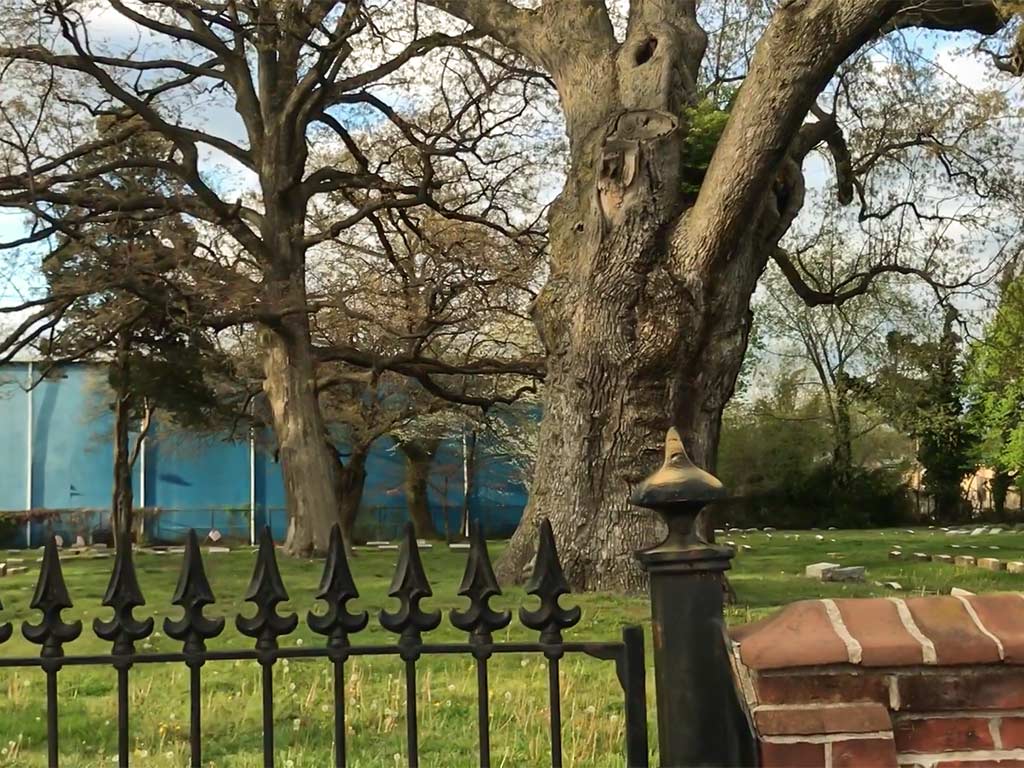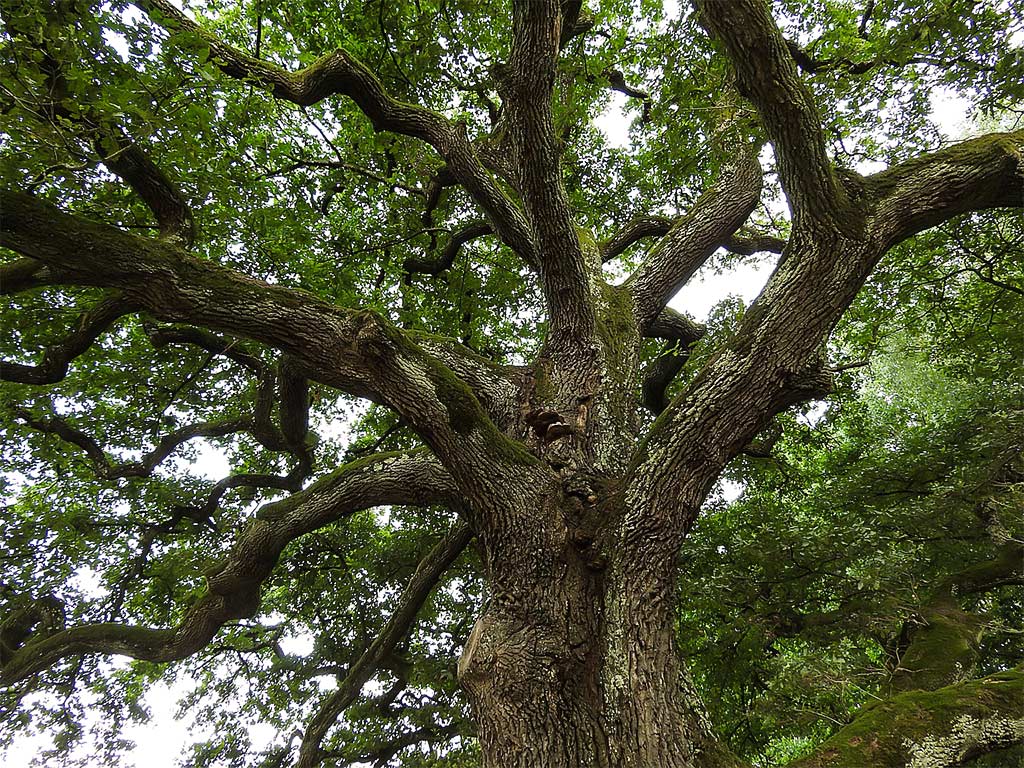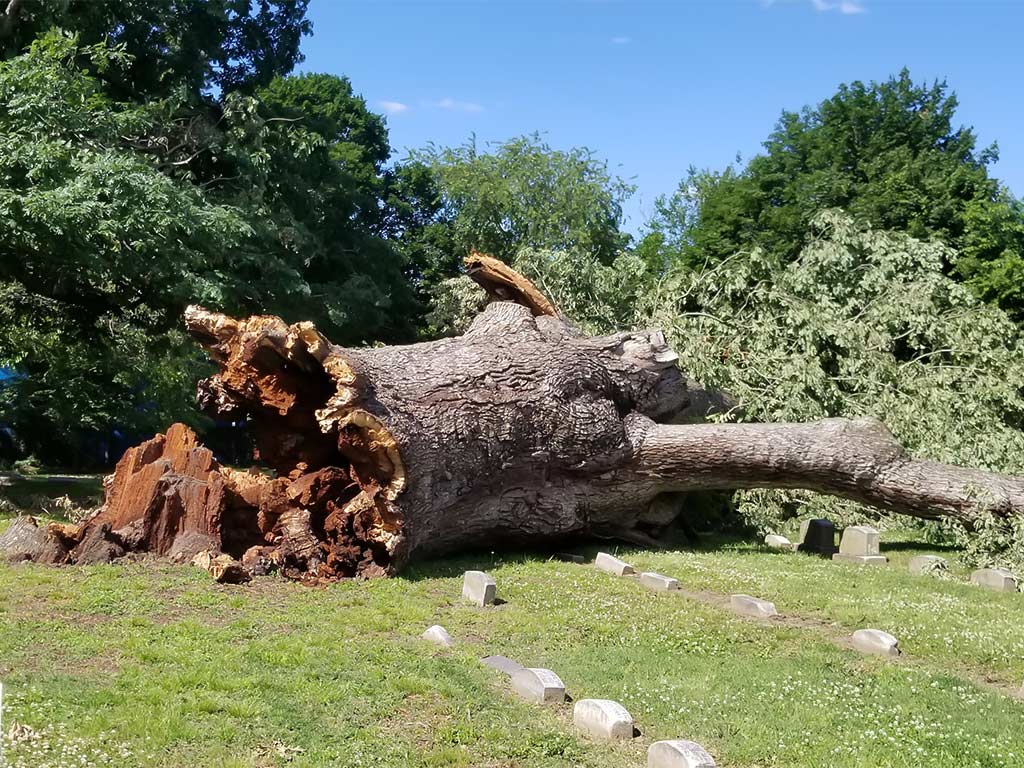The Salem Oak Tree, a towering white oak, stood as a silent witness to centuries of history in Salem County, New Jersey.
Revered as the tallest white oak in the state, this nearly 600-year-old giant was more than just a tree; it was a symbol of endurance and a cherished landmark for the local community.
Its branches stretched over the Salem Religious Society of Friends’ graveyard, intertwining the past and the present in its sprawling canopy.
Residents deeply mourned when the iconic tree finally succumbed to age and declining health on June 6, 2019. For over a century, efforts to preserve this majestic oak were relentless, reflecting its profound significance to Salem’s heritage.
Jim Waddington, a member of the Salem Religious Society of Friends, poignantly remarked on the sadness that enveloped the community, underscoring the tree’s integral role in their shared history.
The Historical Significance of the Salem Oak Tree

The Salem Oak Tree holds significant historical and cultural importance, particularly in relation to the Salem Witch Trials of 1692.
Although not directly involved in the trials themselves, the tree has become intertwined with the narrative of that dark period in American history.
The Legend Behind the Tree
The Salem Oak Tree held a unique place in local folklore. According to tradition, the tree was the last survivor of the original forest covering Salem County.
The most notable legend associated with the tree involves John Fenwick, the founder of Salem. In 1675, he is said to have negotiated a peace treaty with the Lenni-Lenape indigenous tribe under its sprawling branches.
This event marked the beginning of Salem’s settlement, and the tree became a living symbol of peace and mutual respect between settlers and the native community.
Important Events Associated with the Salem Oak
The Salem Oak stood witness to numerous significant events over its nearly 600-year lifespan. The tree was recognized as a Millennial Landmark Tree and named among the top 50 trees in the country for its historical significance.
Efforts to preserve it included installing lightning rods and cables to support its branches. Many of Salem’s earliest residents, including prominent Quaker community members, were buried beneath its canopy.
In addition to its connection to John Fenwick’s treaty, the tree was a cherished symbol for the Quaker community and Salem residents.
They gathered at the tree for various events, fostering a sense of community and continuity. Despite its collapse on June 6, 2019, the Salem Oak’s legacy endures through its descendants, planted in private backyards and parks across the country.
These saplings ensure that the historical and cultural significance of the original tree remains alive for future generations.
Ecological and Biological Aspects

Beyond its historical significance, the Salem Oak Tree also plays a crucial role in its ecological and biological environment.
Here are some aspects to consider:
Species Details of the Salem Oak
The Salem Oak, a White Oak (Quercus alba), stood as one of the oldest and tallest of its kind in New Jersey. Notably, the tree measured 103 feet in height and had a circumference of 22 feet.
White Oaks are known for their longevity and robust wood, making them pillars of forest ecosystems.
Characterized by their lobed leaves and acorns, these trees provide crucial habitats and food sources for various wildlife species including birds, squirrels, and deer.
The Salem Oak’s age, estimated between 500 and 600 years, signifies its remarkable resilience to environmental changes over centuries.
Ecological Impact on the Surroundings
The Salem Oak played a significant role in its local ecosystem, influencing both flora and fauna within its vicinity. Serving as a keystone species, it contributed to soil stability and nutrient cycling by shedding leaves that decomposed to enrich the soil.
Its expansive canopy provided shade, reducing ground temperature and creating a microhabitat favorable for shade-tolerant plants.
Additionally, the tree’s acorns were a vital food source for local wildlife, supporting a diverse range of species.
Even after its collapse, the ecological footprint of the Salem Oak endures through its seedlings, fostering continued biodiversity in the region.
The Salem Oak in Culture and Folklore

The Salem Oak Tree has deeply embedded itself in the culture and folklore of the region, inspiring stories, traditions, and superstitions passed down through generations.
Here are some ways it has influenced local culture:
The Salem Oak in Literature and Art
The Salem Oak has featured prominently in various literary and artistic works. As the site where Quaker John Fenwick brokered a treaty with the Lenni Lenape Native American tribe in 1675, the tree’s historical footprint has inspired numerous historical novels and poems.
Local authors often integrate the Salem Oak’s symbolism of peace and resilience into their narratives. Artists have captured the tree’s grandeur in paintings and illustrations, creating iconic images that reflect its deep-rooted significance in Salem’s cultural heritage.
Modern Cultural References
In modern times, the Salem Oak continues to hold cultural relevance. Salem County residents expressed profound sorrow when the tree collapsed in 2019, demonstrating its emotional importance to the community.
The tree’s legacy lives on through dedications and memorials, as well as through public gatherings that honor its historical contributions.
Preservation efforts and narratives about the Salem Oak frequently appear in local news and social media, highlighting the community’s ongoing connection to this historical landmark.
Additionally, educational programs use the Salem Oak to teach regional history, emphasizing the tree’s role in shaping the cultural landscape of Salem.
Preservation Efforts
Preservation efforts for the Salem Oak Tree are vital not only to maintain its cultural and ecological significance but also to ensure its survival for future generations.
Here are some key strategies and initiatives that contribute to its preservation:
Conservation Challenges
Significant preservation efforts targeted the Salem Oak Tree over recent decades, reflecting its historical and cultural importance.
The tree, being the largest white oak in New Jersey, faced numerous challenges due to its age and natural wear.
Fertilization initiatives aimed to boost its health while cables were erected to stabilize its hefty branches. Despite these measures, the tree’s health steadily declined over the last 100 years.
Environmental factors also posed threats. To protect against lightning strikes, lightning rods were installed around the tree.
While these steps showcased the community’s dedication to the tree’s longevity, they couldn’t prevent its eventual collapse in 2019.
The state Department of Environmental Protection had recognized the tree’s vulnerability and ranked it as the largest white oak requiring continuous care.
Community Engagement in Preservation
The Salem Oak Tree’s preservation saw strong community engagement. Residents of Salem County, deeply connected to the tree’s heritage, actively participated in preservation activities.
The Salem Religious Society of Friends, the tree’s owner, played a critical role. They managed the surrounding graveyard and implemented several conservation strategies.
Local journalist Bill Gallo extensively reported on the tree’s condition, raising public awareness. Events and gatherings organized around the tree fostered a collective effort to cherish and protect it.
These communal acts showcased the tree’s significance beyond its physical presence, embedding it in the cultural fabric of Salem.
Frequently Asked Questions
What is the historical significance of the Salem Oak Tree?
The Salem Oak Tree played a vital role in peace treaty negotiations with the Lenape tribe and served as a central landmark for community events in Salem County, New Jersey. It symbolizes the area’s rich history and cultural heritage.
When did the Salem Oak Tree collapse?
The Salem Oak Tree collapsed on June 6, 2019, ending its lifespan of over 500 years. Despite its fall, its legacy continues through its descendants planted across the nation.
What species was the Salem Oak Tree?
The Salem Oak Tree was a White Oak (Quercus alba). This species is known for its longevity, resilience, and significant ecological contributions to its environment.
How old was the Salem Oak Tree?
The age of the Salem Oak Tree was estimated to be between 500 and 600 years, making it a resilient symbol of environmental endurance and historical significance.
Why is the Salem Oak Tree considered a keystone species?
As a keystone species, the Salem Oak provided crucial habitats and food sources for various wildlife, contributed to soil stability, nutrient cycling, and supported biodiversity in its ecosystem.
Conclusion
The Salem Oak Tree’s story is a testament to the enduring connection between nature and community. Its historical, ecological, and cultural significance has left an indelible mark on Salem County and beyond.
Though the original tree has fallen, its legacy thrives through its descendants and the community’s unwavering commitment to preservation.
The Salem Oak continues to inspire and symbolize resilience, bridging the past and future in a profound way. As we celebrate this iconic tree, educational programs and conservation efforts ensure that its story is passed to future generations.
This majestic oak’s legacy lives on, reminding us of our shared history and the importance of safeguarding our natural heritage.
Jaclyn Lowe